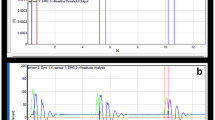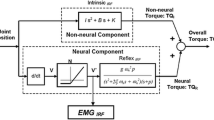Abstract
Deep tendon reflexes are one of the main parameters of the neurological examination in many diseases. Reflex responses increase in upper motor neuron diseases due to a lack of suprasegmental control such as spasticity and rigidity. This information provided by the reflex response makes it an indispensable element of neurological examination. However, an important limitation is that this assessment is subjective. In this study, EMG and kinesiology measurements were recorded together during the assessment of the patellar T reflex in healthy control, spasticity, and Parkinson’s disease groups. Nine kinesiologic and three electrophysiologic features were extracted. We validated the proposed method with three healthy participants by ten repeated measurements on 6 different days and we observed that angular velocity is the most stable parameter. Clustering of different groups determined with K-clustering and artificial neural network used for classification with kinesiological and EMG inputs. Our findings show that reflex grade can be determined with high accuracy (Acc = 98.6) in a large population for both pathological and healthy groups and angular velocity is sufficient for reflex grading. Therefore, we think that our study will contribute to the literature by providing an approach with high reliability and reproducibility in the quantitative assessment of reflexes.
Graphical abstract






Similar content being viewed by others
References
Burke D, Gillies J, Lance JW (1970) The quadriceps stretch reflex in human spasticity. J Neurol Neurosurg Psychiatry 33(2):216. https://doi.org/10.1136/jnnp.33.2.216
Lance J, Burke D, Andrews C (1973) The reflex effects of muscle vibration in human reflexes, pathophysiology of motor systems, Methodology of human reflexes, vol. 3: Karger Publishers, pp. 444–462. https://doi.org/10.1159/000394159.
Pierrot-Deseilligny E, Burke D (2005) The circuitry of the human spinal cord: its role in motor control and movement disorders. Cambridge University Press. https://doi.org/10.1017/CBO9780511545047
Burke D, Andrews CJ, Lance JW (1972) Tonic vibration reflex in spasticity, Parkinson’s disease, and normal subjects. J Neurol Neurosurg Psychiatry 35(4):477–486. https://doi.org/10.1136/jnnp.35.4.477
Burke D, Gillies J, Lance JW (1971) Hamstrings stretch reflex in human spasticity. J Neurol Neurosurg Psychiatry 34(3):231–235. https://doi.org/10.1136/jnnp.34.3.231
Voerman GE, Gregorič M, Hermens HJ (2005) Neurophysiological methods for the assessment of spasticity: the Hoffmann reflex, the tendon reflex, and the stretch reflex. Disabil Rehabil 27(1–2):33–68. https://doi.org/10.1080/09638280400014600
Xu D, Guo X, Yang C-Y, Zhang L-Q (2015) Assessment of hyperactive reflexes in patients with spinal cord injury. Biomed Res Int 2015. https://doi.org/10.1155/2015/149875
Hallett M (1993) NINDS myotatic reflex scale. Neurology 43(12):2723–2723. https://doi.org/10.1212/WNL.43.12.2723
Litvan I et al (1996) Reliability of the NINDS myotatic reflex scale. Neurology 47(4):969–972. https://doi.org/10.1212/WNL.47.4.969
Manschot S, Van Passel L, Buskens E, Algra A, Van Gijn J (1998) Mayo and NINDS scales for assessment of tendon reflexes: between observer agreement and implications for communication. J Neurol Neurosurg Psychiatry 64(2):253–255. https://doi.org/10.1136/jnnp.64.2.253
Stam J, Van Crevel H (1990) Reliability of the clinical and electromyographic examination of tendon reflexes. J Neurol 237(7):427–431. https://doi.org/10.1007/BF00314735
Lemoyne R, Mastroianni T, Coroian C, Grundfest W (2011) Tendon reflex and strategies for quantification, with novel methods incorporating wireless accelerometer reflex quantification devices, a perspective review. J Mech Med Biol 11(03):471–513. https://doi.org/10.1142/S0219519410003733
Cozens JA, Miller S, Chambers IR, Mendelow AD (2000) Monitoring of head injury by myotatic reflex evaluation. J Neurol Neurosurg Psychiatry 68(5):581–588. https://doi.org/10.1136/jnnp.68.5.581
Faist M, Ertel M, Berger W, Dietz V (1999) Impaired modulation of quadriceps tendon jerk reflex during spastic gait: differences between spinal and cerebral lesions. Brain 122(3):567–579. https://doi.org/10.1093/brain/122.3.567
Lebiedowska MK, Fisk JR (2003) Quantitative evaluation of reflex and voluntary activity in children with spasticity. Arch Phys Med Rehabil 84(6):828–837. https://doi.org/10.1016/S0003-9993(02)04946-8
Lemoyne R, Mastroianni T, Coroian C, Grundfest W (2010) Wireless three dimensional accelerometer reflex quantification device with artificial reflex system. J Mech Med Biol 10(03):401–415. https://doi.org/10.1142/S0219519410003472
Lemoyne R et al (2011) Fourth generation wireless reflex quantification system for acquiring tendon reflex response and latency. J Mech Med Biol 11(01):31–54. https://doi.org/10.1142/S0219519410003654
Mamizuka N, Sakane M, Kaneoka K, Hori N, Ochiai N (2007) Kinematic quantitation of the patellar tendon reflex using a tri-axial accelerometer. J Biomech 40(9):2107–2111. https://doi.org/10.1016/j.jbiomech.2006.10.003
Pagliaro P, Zamparo P (1999) Quantitative evaluation of the stretch reflex before and after hydro kinesy therapy in patients affected by spastic paresis. J Electromyogr Kinesiol 9(2):141–148. https://doi.org/10.1016/s1050-6411(98)00045-5
Van de Crommert H, Faist M, Berger W, Duysens J (1996) Biceps femoris tendon jerk reflexes are enhanced at the end of the swing phase in humans. Brain Res 734(1–2):341–344. https://doi.org/10.1016/0006-8993(96)00885-2
Beres-Jones JA, Johnson TD, Harkema SJ (2003) Clonus after human spinal cord injury cannot be attributed solely to recurrent muscle-tendon stretch. Exp Brain Res 149(2):222–236. https://doi.org/10.1007/s00221-002-1349-5
Uysal H, Boyraz İ, Yağcıoğlu S, Oktay F, Kafalı P, Tönük E (2011) Ankle clonus and its relationship with the medium-latency reflex response of the soleus by peroneal nerve stimulation. J Electromyogr Kinesiol 21(3):438–444. https://doi.org/10.1016/j.jelekin.2010.11.005
Eftekhar B, Mohammad K, Ardebili HE, Ghodsi M, Ketabchi E (2005) Comparison of artificial neural network and logistic regression models for prediction of mortality in head trauma based on initial clinical data. BMC Med Inform Decis Mak 5(1):1–8. https://doi.org/10.1186/1472-6947-5-3
Jaimes F, Farbiarz J, Alvarez D, Martínez C (2005) Comparison between logistic regression and neural networks to predict death in patients with suspected sepsis in the emergency room. Crit Care 9(2):1–7. https://doi.org/10.1186/cc3054
Liang Y, Li Q, Chen P, Xu L, Li J (2019) Comparative study of back propagation artificial neural networks and logistic regression model in predicting poor prognosis after acute ischemic stroke. Open Med 14(1):324–330. https://doi.org/10.1515/med-2019-0030
Loukas C, Brown P (2004) Online prediction of self-paced hand-movements from subthalamic activity using neural networks in Parkinson’s disease. J Neurosci Methods 137(2):193–205. https://doi.org/10.1016/j.jneumeth.2004.02.017
Shafiei E, Fakharian E, Omidi A, Akbari H, Delpisheh A, Nademi A (2017) Comparison of artificial neural network and logistic regression models for prediction of psychological symptom six months after mild traumatic brain injury. Iran J Psychiatry Behav Sci 11:3. https://doi.org/10.17795/ijpbs-5849
Milewski R, Milewska AJ, Więsak T, Morgan A (2013) Comparison of artificial neural networks and logistic regression analysis in pregnancy prediction using the in vitro fertilization treatment. Stud Logic, Grammar Rhetoric 35(1):39–48. https://doi.org/10.2478/slgr-2013-0033
Tu JV (1996) Advantages and disadvantages of using artificial neural networks versus logistic regression for predicting medical outcomes. J Clin Epidemiol 49(11):1225–1231. https://doi.org/10.1016/S0895-4356(96)00002-9
Shi H-Y et al (2012) Comparison of artificial neural network and logistic regression models for predicting in-hospital mortality after primary liver cancer surgery. PLoS ONE 7(4):e35781. https://doi.org/10.1371/journal.pone.0035781
Ashworth B (1964) Preliminary trial of carisoprodol in multiple sclerosis. Practitioner 192:540–542
Goetz CG et al (2008) Movement Disorder Society-sponsored revision of the Unified Parkinson’s Disease Rating Scale (MDS-UPDRS): scale presentation and clinimetric testing results. Mov Disord 23(15):2129–2170. https://doi.org/10.1002/mds.22340
Boyraz I, Uysal H, Koc B, Sarman H (2015) Clonus: definition, mechanism, treatment. Med Glas (Zenica) 12(1):19–26
Gürbüz M, Bilgin S, Albayrak Y, Kızılay F, Uysal H (2015) Biceps femoris late latency responses and the “notching sign” in spasticity. J Neuroeng Rehabil 12(1):1–10. https://doi.org/10.1186/s12984-015-0084-7
Uslu S, Nuzket T, Albayrak Y, Uysal H (2016) Evaluation of the patellar tendon reflex with reflex hammer that can measure impact force, muscle vibration and CMAP. J Neurol Sci 33:2
Uslu S, Nüzket T, Albayrak Y, Uysal H (2015) “Detarmination of patellar T EMG response with the Deep Tendon Reflex grading and tapping force.” In 2015 19th National Biomedical Engineering Meeting (BIYOMUT), 2015: IEEE, pp. 1–4, doi: https://doi.org/10.1109/BIYOMUT.2015.7369465.
Uslu S, Nuzket T, Uysal H (2018) Modified motor unit number index (MUNIX) algorithm for assessing excitability of alpha motor neuron in spasticity. Clin Neurophysiol Pract 3:127–133. https://doi.org/10.1016/j.cnp.2018.05.002
Likas A, Vlassis N, Verbeek JJ (2003) The global k-means clustering algorithm. Pattern Recogn 36(2):451–461. https://doi.org/10.1016/S0031-3203(02)00060-2
Lemoyne R, Dabiri F, Jafari R (2008) Quantified deep tendon reflex device, second generation. J Mech Med Biol 8(01):75–85. https://doi.org/10.1142/S0219519408002462
Lemoyne R, Coroian C, Mastroianni T, Grundfest W (2008) Quantified deep tendon reflex device for response and latency, third generation. J Mech Med Biol 8(04):491–506. https://doi.org/10.1142/S0219519408002772
Stecco A, Stecco C, Raghavan P (2014) Peripheral mechanisms contributing to spasticity and implications for treatment. Curr Phys Med Rehabil Rep 2(2):121–127. https://doi.org/10.1007/s40141-014-0052-3
Lorentzen J, Grey MJ, Crone C, Mazevet D, Biering-Sørensen F, Nielsen JB (2010) Distinguishing active from passive components of ankle plantar flexor stiffness in stroke, spinal cord injury and multiple sclerosis. Clin Neurophysiol 121(11):1939–1951. https://doi.org/10.1016/j.clinph.2010.02.167
O’Sullivan R, Kiernan D, Walsh M, O’Brien T, Elhassan Y (2016) Characterisation of the patellar tendon reflex in cerebral palsy children using motion analysis. Ir J Med Sci 185(4):813–817. https://doi.org/10.1007/s11845-015-1369-3
Uslu S, Gurbuz M, Kizilay F, Ozkaynak S, Nuzket T, Uysal H (2021) Amplitude and velocity dependence of patellar pendulum triggered by T reflex in Parkinson’s rigidity. Neurol Sci 42(8):3257–3266. https://doi.org/10.1007/s10072-020-04936-y
Krishnasamy G, Kulkarni AJ, Paramesran R (2014) A hybrid approach for data clustering based on modified cohort intelligence and K-means. Expert Syst Appl 41(13):6009–6016. https://doi.org/10.1016/j.eswa.2014.03.021
Raykov YP, Boukouvalas A, Baig F, Little MA (2016) What to do when k-means clustering fails: a simple yet principled alternative algorithm. PLoS ONE 11(9):e0162259. https://doi.org/10.1371/journal.pone.0162259
Zheng B, Yoon SW, Lam SS (2014) Breast cancer diagnosis based on feature extraction using a hybrid of K-means and support vector machine algorithms. Expert Syst Appl 41(4):1476–1482. https://doi.org/10.1016/j.eswa.2013.08.044
Lebiedowska MK, Sikdar S, Eranki A, Garmirian L (2011) Knee joint angular velocities and accelerations during the patellar tendon jerk. J Neurosci Methods 198(2):255–259. https://doi.org/10.1016/j.jneumeth.2011.04.018
Acknowledgements
We thank the patients for their cooperation. The study was supported by The Scientific and Technological Research Council of Turkey Grant (grant number: 214 S 175).
Author information
Authors and Affiliations
Corresponding author
Ethics declarations
Conflict of interest
The authors declare no competing interests.
Additional information
Publisher's note
Springer Nature remains neutral with regard to jurisdictional claims in published maps and institutional affiliations.
Supplementary Information
Below is the link to the electronic supplementary material.
Rights and permissions
Springer Nature or its licensor holds exclusive rights to this article under a publishing agreement with the author(s) or other rightsholder(s); author self-archiving of the accepted manuscript version of this article is solely governed by the terms of such publishing agreement and applicable law.
About this article
Cite this article
Uslu, S., Nüzket, T., Gürbüz, M. et al. Electrophysiological and kinesiological analysis of deep tendon reflex responses, importance of angular velocity. Med Biol Eng Comput 60, 2917–2929 (2022). https://doi.org/10.1007/s11517-022-02638-5
Received:
Accepted:
Published:
Issue Date:
DOI: https://doi.org/10.1007/s11517-022-02638-5




